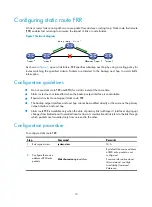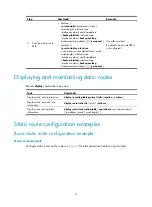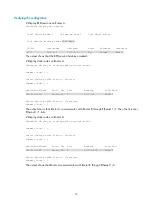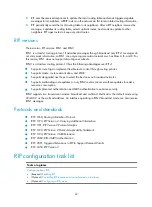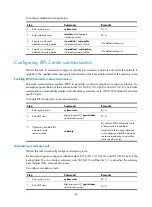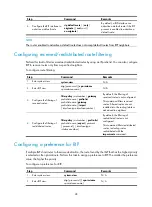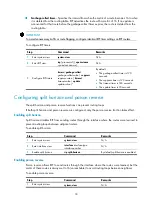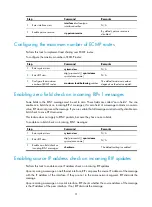
18
Summary Count : 1
Destination/Mask Proto Pre Cost NextHop Interface
120.1.1.0/24 Static 65 0 10.1.1.100 Eth1/2
Static Routing table Status : <Inactive>
Summary Count : 0
The output shows that Router A communicates with Router B through Ethernet 1/2.
Static route FRR configuration example
Network requirements
As shown in
, configure static routes on Router S, Router A, and Router D, and configure static
route FRR so when Link A becomes unidirectional, traffic can be switched to Link B immediately.
Figure 5
Network diagram
Configuration procedure
1.
Configure IP addresses for interfaces. (Details not shown.)
2.
Configure static routes FRR on link A:
# Configure a static route on Router S, and specify Ethernet 1/1 as the backup output interface
and 12.12.12.2 as the backup next hop.
<RouterS> system-view
[RouterS] bfd echo-source-ip 4.4.4.4
[RouterS] ip route-static 4.4.4.4 32 ethernet 1/2 13.13.13.2 backup-interface
ethernet 1/1 backup-nexthop 12.12.12.2
# Configure a static route on Router D, and specify Ethernet 1/1 as the backup output interface
and 24.24.24.2 as the backup next hop.
<RouterD> system-view
[RouterD] bfd echo-source-ip 1.1.1.1
[RouterD] ip route-static 1.1.1.1 32 ethernet 1/2 13.13.13.1 backup-interface
ethernet 1/1 backup-nexthop 24.24.24.2
3.
Configure static routes on Router A.
<RouterA> system-view
[RouterA] ip route-static 4.4.4.4 32 ethernet 1/2 24.24.24.4
[RouterA] ip route-static 1.1.1.1 32 ethernet 1/1 12.12.12.1
Verifying the configuration
# Display route 4.4.4.4/32 on Router S to view the backup next hop information.







